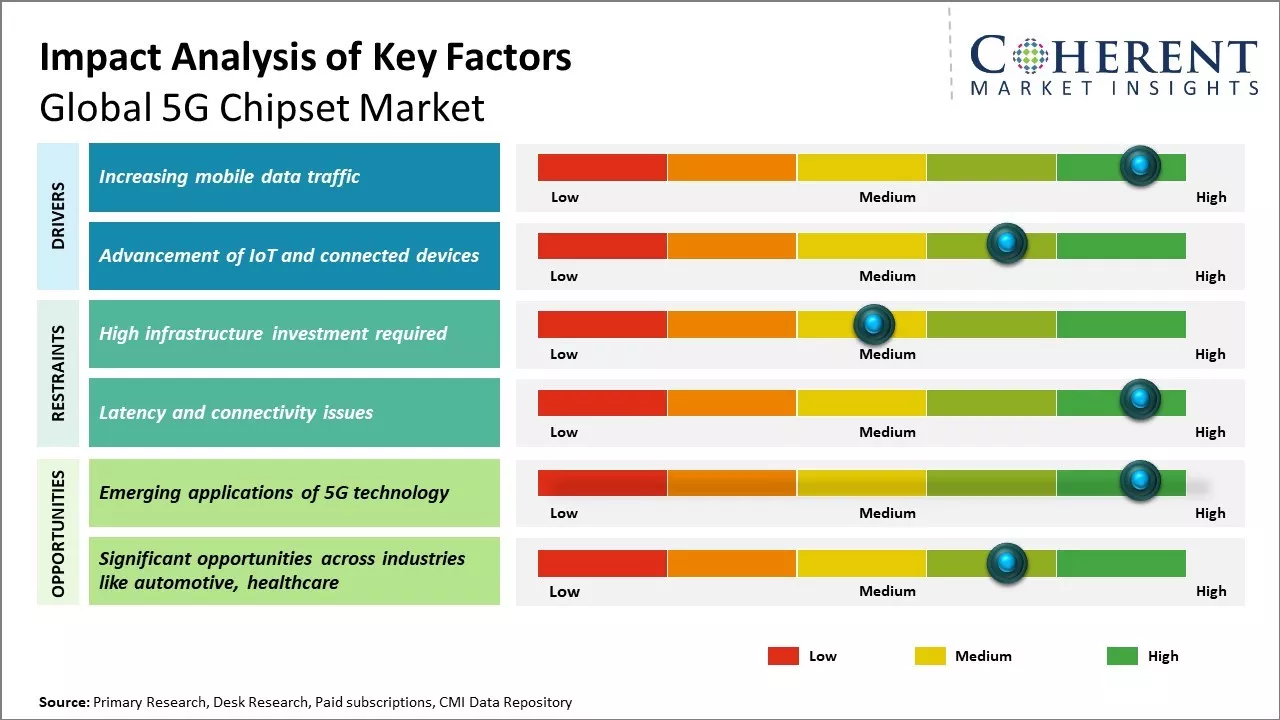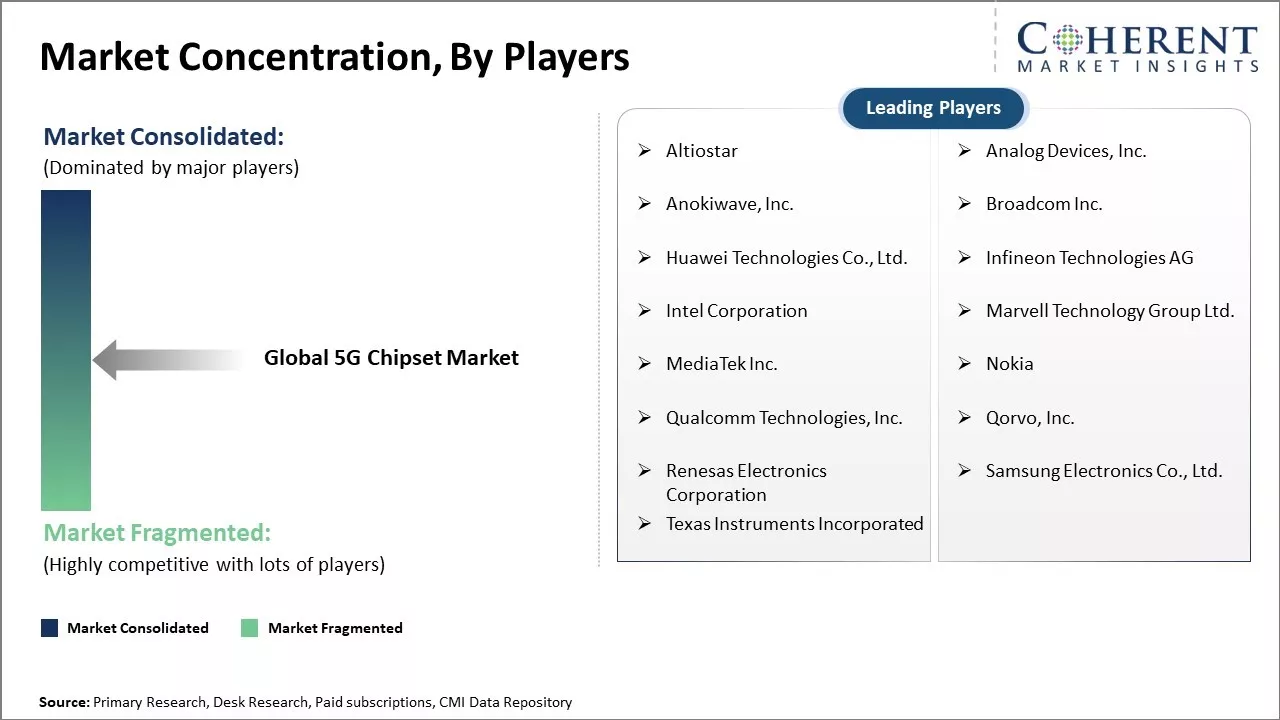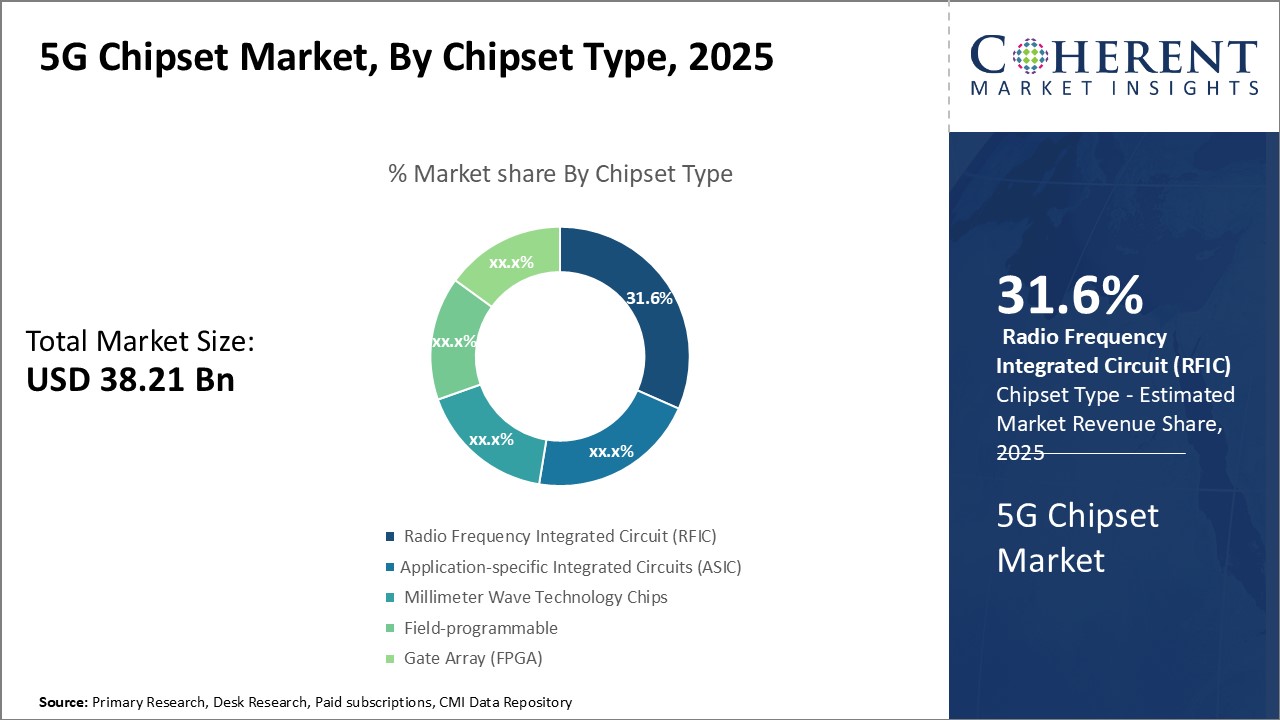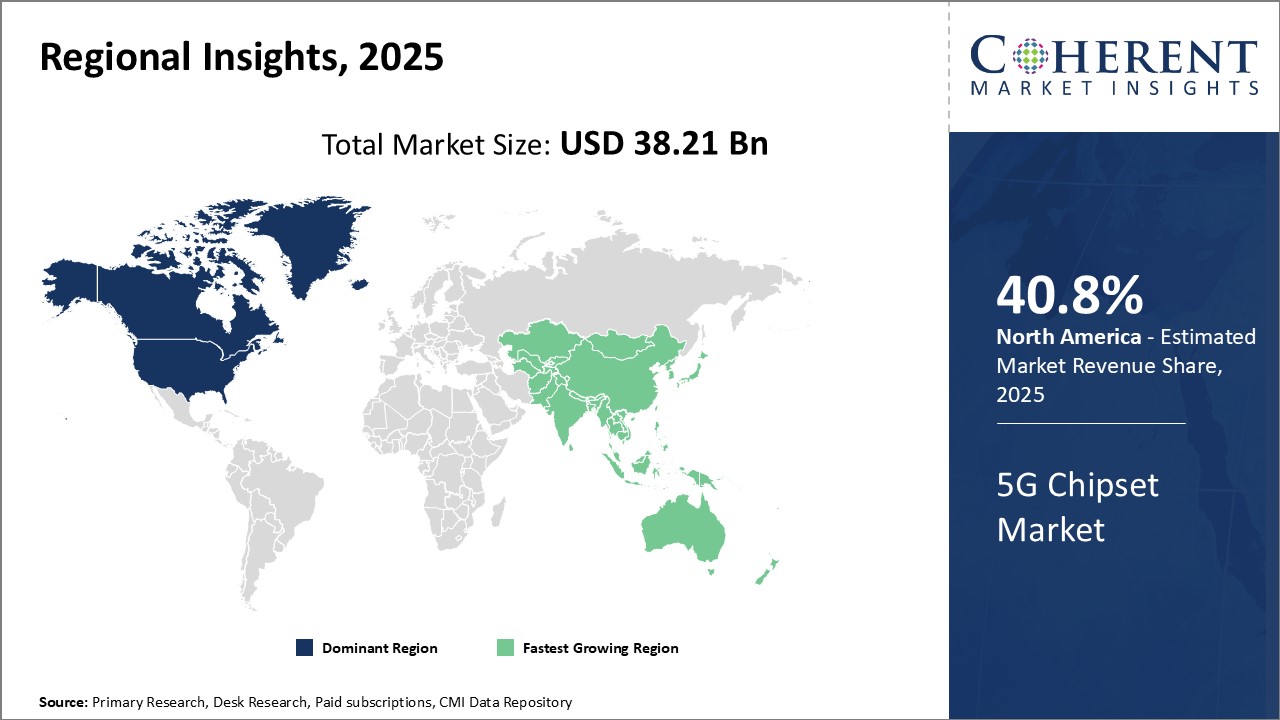The Global 5G Chipset Market is estimated to be valued at US$ 32.05 Bn in 2024 and is expected to reach US$ 108.52 Bn by 2031, exhibiting a compound annual growth rate (CAGR) of 19% from 2024 to 2031.

To learn more about this report, request sample copy
The 5G chipset market growth is driven by increasing adoption of smartphones and mobile broadband services compatible with 5G technology. Growing mobile data traffic and rising need for high-speed internet are further fueling the adoption of 5G networks among telecom operators. 5G provides low-latency and high-bandwidth connections which is expanding its usage in applications such as autonomous driving, IoT, AR/VR, and industrial robotics. Leading telecom players make significant investments for deploying 5G infrastructure which is generating strong demand for 5G chipsets from telecom equipment manufacturers. Furthermore, reduction in 5G chipset prices with technology advancements is expected to increase its affordability and adoption rate globally during the forecast period.
Increasing mobile data traffic
The ever-growing demand for bandwidth is one of the key drivers of the global 5G chipset market growth. As smartphones and other wireless devices become more sophisticated with multiple cameras, HD, and even 4K displays, as well as new applications like VR and AR, the amount of mobile data being consumed continues to rise exponentially. With more users now streaming video and accessing rich media content on the go, they expect fast and reliable internet access wherever they are. 5G technology promises data speeds that are 10-100 times faster than current 4G LTE networks, with ultra-low latency. This will enable data-heavy applications and use cases which were not possible before. The ability of 5G networks to meet the surging bandwidth demand from both consumers and businesses is vital, driving the need for 5G chipsets that can support these advanced capabilities.

Get actionable strategies to beat competition: Get instant access to report
Advancement of IoT and connected devices
The growth of IoT (Internet of Things) and connectivity of more "things" to the internet is another major driver for 5G chipsets demand. Application areas ranging from smart cities and industrial automation to consumer wearables, healthcare devices, and automotive telematics will all leverage connectivity enabled by 5G. The demands of IoT are very different from traditional smartphones - requirements include supporting massive number of low-power devices, ultra-reliable low latency communication for mission-critical applications as well as mobility. Current cellular technologies struggle to meet these requirements. 5G on the other hand has been designed from the ground up with IoT use cases in mind, featuring capabilities such as reduced network latency and ability to support much larger numbers of low bandwidth connections simultaneously. As a result, 5G chipsets that enable these advanced IoT connectivity capabilities are seeing heavy demand. The rapid growth of IoT is a key force driving the global 5G chipset market forward.
Key Takeaways from Analyst:
Major drivers for the global 5G chipset market growth include increasing 5G deployments worldwide as well as the launch of advanced 5G-enabled smartphones and other IoT devices. 5G chipsets will see widespread integration across a variety of connected devices and industrial applications that require low latency connectivity.
North America is expected to dominate the 5G chipset market owing to early large-scale 5G network deployments and strong governmental support for indigenous development of 5G technologies. Manufacturers based in the region also have a significant advantage in terms of production capabilities and supply chain ecosystem.
However, the availability of fragmented spectrum holdings and lack of harmonized standards may negatively impact the speed of 5G commercialization across different markets. High end-use equipment costs stemming from deploying new infrastructure and capability to utilize mmWave spectrum bands pose a restraint. Additionally, uncertainties around the rollout of secondary 5G use cases beyond enhanced mobile broadband could slow down demand growth.
Nevertheless, rapid technological innovations and decreasing 5G chipset prices over time are likely to drive further uptake. Expanding application of 5G in autonomous driving, augmented/virtual reality, and remote healthcare offers potential growth opportunities.
Market Challenges: High infrastructure investment required
The massive infrastructure upgrade required to support 5G networks around the world has undoubtedly been one of the biggest brakes on the growth trajectory of the 5G chipset market. Rolling out 5G requires a complete overhaul of the existing telecom infrastructure with the installation of many more base stations and towers compared to previous generations of wireless technology. This is because 5G networks have shorter range and need many localized network enhancements to deliver the lower latency and higher speeds that the technology promises. However, making such large infrastructure investments has proved challenging for many telecom operators who are still recovering from their 4G network rollouts.
Market Opportunities: Emerging applications of 5G technology
The emerging applications of 5G technology promises to be a great growth opportunity for the global 5G chipset market in the coming years. 5G is expected to enable a whole new generation of applications and use cases that require ultra-low latency and high bandwidth. New applications such as augmented reality/virtual reality, autonomous driving, telemedicine, smart cities, and industrial IoT are likely to see huge growth once 5G networks are widely deployed globally.
By enhancing connectivity and experience, 5G will play a vital role in further advancing these new technologies. For example, applications like autonomous driving requires near real-time connectivity to function safely on roads. A low latency 5G network can help transmit critical driving data from sensors instantly. Industries are also looking to leverage 5G to automate complex processes and increase efficiency through techniques like distributed robotics which need reliable high-speed connectivity. The healthcare sector too is exploring innovative telemedicine applications such as remote surgery which depends on fast, low latency 5G networks for seamless connectivity.

Discover high revenue pocket segments and roadmap to it: Get instant access to report
Insights By Chipset Type - RF Technology Advancements Drive RFIC Chip Demand
The Radio Frequency Integrated Circuit (RFIC) segment is projected to capture a 31.1% market share in 2024, fueled by ongoing advancements in RF technology. RFICs are essential for 5G infrastructure, as they manage the high frequencies required for these networks. Unlike previous cellular standards, 5G demands broader bandwidths and more sophisticated RF designs to facilitate features such as beamforming and massive MIMO.
Consequently, there is a significant demand for advanced RFICs capable of efficiently handling frequencies from traditional sub-6GHz to millimeter wave bands. Key RFIC manufacturers are heavily investing in research and development to produce highly integrated multi-mode RFIC solutions. These solutions streamline network deployments by enabling simultaneous support for multiple cellular standards on a single hardware platform, thereby facilitating a seamless transition to 5G.
Moreover, innovations in manufacturing technologies, such as FinFET, are leading to the development of single-chip RFICs that offer enhanced power efficiency and compact form factors. These advancements broaden the applicability of RFICs across various 5G applications and network infrastructure components.
Insights By Operational Frequency - 26 And 39 GHz Segment Enabled New Spectrum Drives Chip Demand
The 26-39 GHz segment is estimated to hold a 46.2% share of the 5G chipset market in 2024, driven by new opportunities enabled by this spectrum. 5G networks operating in the 26-39 GHz band, commonly known as millimeter-wave (mmWave) frequencies, provide significantly higher wireless network speeds compared to existing cellular networks. However, mmWave 5G signals have shorter range and greater difficulty in penetrating solid objects compared to existing cellular bands below 6 GHz. To overcome these limitations, mmWave 5G networks require denser antenna/small cell deployments with micro-coverage and beamforming capabilities.
While mmWave 5G will continue to see healthy upgrades, the sub-6GHz segment covering existing LTE bands below 6GHz holds the potential to become the fastest growing in terms of 5G chipset shipments. Sub-6GHz frequencies offer better penetration through walls and other materials compared to mmWave. As a result, they are expected to play a key role in the internet of things (IoT) applications by enabling cost-effective, ubiquitous indoor 5G connectivity.
Insights By Vertical - IT & Telecom Sector Drives Maximum 5G Chip Demand
In terms of Vertical, the IT & Telecom segment is estimated to hold 41.3% share of the global 5G chipset market in 2024 due to large scale investments by telecom operators. 5G networking requires a complete overhaul of the infrastructure with new network elements, small cells and edge computing hardware. This presents a massive opportunity for 5G chipset vendors to provide core silicon to cellular infrastructure OEMs and telecom equipment manufacturers. Telecom operators are aggressively deploying 5G networks globally to deliver enhanced mobile broadband and launch new consumer and enterprise services. They are also upgrading existing cell sites to support 5G-NR along with traditional LTE/3G/2G connectivity. 5G infrastructure buildsout relies on various system on chips (SoCs) across routers, switches, RAN/small cells and backhaul systems. Therefore, the IT & telecom vertical remains the largest early adopter and biggest demander of 5G-capable chipset solutions during the initial network upgrade cycles.

To learn more about this report, request sample copy
North America has dominated the global 5G chipset market and is projected to continue its dominance during the forecast period with an estimated 40.3% share in 2024. The strong presence of major chipset providers in the U.S., such as Qualcomm and Intel, give the region an edge. There is a high focus on R&D which has enabled regular innovations and development of cutting-edge 5G chipset solutions. Furthermore, early and rapid deployment of 5G networks by telecom players like Verizon and AT&T has fueled the demand for 5G chipsets in the region.
Asia Pacific has emerged as the fastest growing regional market for 5G chipsets. Countries like China, South Korea, and Japan are frontrunners in 5G deployment and are aggressively investing in building 5G infrastructure. China, in particular, presents lucrative opportunities attributed to the nation's massive planned investments in 5G infrastructure and push for indigenous 5G technology development. Growing export orientation of 5G chipset manufacturers as well as rapidly expanding domestic market are driving growth. Additionally, supportive government policies and availability of cheap labor have helped Asia establish itself as the manufacturing hub, thereby boosting shipments of 5G chipsets from the region.
Countries within Asia are increasingly trading 5G chipsets among themselves. While China and South Korea actively export, countries like India and Indonesia offer vast untapped opportunities with their huge subscriber base and growing focus on digitization. However, the ongoing trade war has increased import costs for some Asian countries. Despite short-term hurdles, the long-term growth prospect of Asia Pacific's 5G chipset market remains promising given the scale of ongoing 5G deployments and continental size of the technology manufacturing sector.
5G Chipset Market Report Coverage
| Report Coverage | Details | ||
|---|---|---|---|
| Base Year: | 2023 | Market Size in 2024: | US$ 32.05 Bn |
| Historical Data for: | 2019 To 2023 | Forecast Period: | 2024 To 2031 |
| Forecast Period 2024 to 2031 CAGR: | 19% | 2031 Value Projection: | US$ 108.52 Bn |
| Geographies covered: |
|
||
| Segments covered: |
|
||
| Companies covered: |
Altiostar, Analog Devices, Inc., Anokiwave, Inc., Broadcom Inc., Huawei Technologies Co., Ltd., Infineon Technologies AG, Intel Corporation, Marvell Technology Group Ltd., MediaTek Inc., Nokia, Qualcomm Technologies, Inc., Qorvo, Inc., Renesas Electronics Corporation, Samsung Electronics Co., Ltd., and Texas Instruments Incorporated |
||
| Growth Drivers: |
|
||
| Restraints & Challenges: |
|
||
Uncover Macros and Micros Vetted on 75+ Parameters: Get Instant Access to Report
*Definition: The Global 5G Chipset Market refers to the market for semiconductor chips and chipsets that enable 5G network connectivity in devices such as 5G smartphones, hotspot devices, connected homes etc. 5G chipsets work with 5G network infrastructure to deliver network speeds many times faster than existing 4G LTE networks as well as provide higher bandwidth and low latency capabilities. Key players in the Global 5G Chipset Market provide 5G system on chips (SoCs), radio frequency integrated circuits (RFICs), millimeter wave integrated circuits (MMwave ICs), and others.
Share
About Author
Pooja Tayade
Pooja Tayade -is an experienced management consultant with a strong background in the Semiconductors and Consumer Electronics industries. Over the past 9 years, she has helped leading global companies in these sectors optimize their operations, drive growth, and navigate complex challenges. She He has led successful projects that delivered significant business impact, such as: Facilitating international expansion for a mid-sized tech enterprise, navigating regulatory compliance in 4 new countries and growing foreign revenue by 50% Implementing lean manufacturing principles that reduced production costs by 15% for a major semiconductor fab
Missing comfort of reading report in your local language? Find your preferred language :
Transform your Strategy with Exclusive Trending Reports :
Frequently Asked Questions
Joining thousands of companies around the world committed to making the Excellent Business Solutions.
View All Our Clients